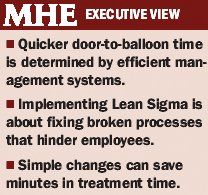Management systems keep hospitals from meeting goals
A few hospital systems already are improving work process by implementing Lean and Six-Sigma management principles. Implementing Lean Sigma (a complementary combination of Lean and Six-Sigma) in a hospital setting is not about fixing problem employees who fail to improve their work. It's about fixing the broken systems and processes that hinder medical professionals from doing what they do best.

A time elapse of under 90 minutes between the patient's arrival at the hospital and intracoronary balloon inflation, otherwise known as door-to-balloon time, is imperative. Research shows what stands in the way of faster treatment isn't technology. Rather it is a host of problems associated with workflow and processes.
Consider the conclusions of the recent studies on reducing door-to-balloon time by Elizabeth H. Bradley, PhD. In the first study, Dr. Bradley states: "We know that reducing door-to-balloon time is important, but now we also have more evidence about how to achieve faster door-to-balloon times. How the hospital processes are organized and managed, and how teams work together within the hospital really matters to patient outcomes, especially in heart attack care, which requires coordination among many different staff members."

"Medical research shows that what's keeping hospitals from speeding treatment often is a management issue. More technology, new treatments and healthcare expertise help, but management systems and processes are what prevent many hospitals from improving their door-to-balloon time," she continues.
LEAN SIGMA IN PRACTICE
A few hospital systems already are improving work process by implementing Lean and Six-Sigma management principles. Implementing Lean Sigma (a complementary combination of Lean and Six-Sigma) in a hospital setting is not about fixing problem employees who fail to improve their work. It's about fixing the broken systems and processes that hinder medical professionals from doing what they do best; empowering each employee to make improvements; reducing time and costs; synchronizing processes; and improving quality and the patient experience.
Among early adopters are some of the most highly regarded healthcare systems in the country: The Cleveland Clinic, The Mayo Clinic and Johns Hopkins, to name a few. They consistently rank among the best hospitals in the world.
How can Lean Sigma help hospitals quickly identify and implement changes in current practice to meet increasingly stringent mandates?
As applied to reducing the door-to-balloon interval, the Lean approach can help hospital personnel identify those activities that are key contributors to the care effort, called "value-added" activities, and separate them from those that do not. This distinction allows those examining the process to question, change and/or potentially eliminate tasks that do not meet the value-added criteria.
For example, one of Chicago's leading hospitals, which has driven its door-to-balloon time down to 63 minutes, eliminated the requirement that a cardiologist diagnose STEMI and prescribe the catheterization. Instead, it allows EMTs or the ED staff to make the decision when their patient presents specific symptoms and 12-lead EKG results. By eliminating the time it had taken for the cardiologist to examine the patient-which required waiting until the patient reached the hospital-the hospital reduced the door-to-balloon interval by 30 minutes.
Although shifting responsibility from a cardiologist to EMTs and ED staff is no small matter, it's supported by medical research. More routine changes, however, can have an equally dramatic effect. Dr. Bradley's research demonstrates the power of eliminating unneeded steps from traditional approaches to treating STEMI. Her research identifies a number of such strategies that are associated with a faster door-to-balloon time, each of which eliminates eight minutes or more.
Clearly, more time-reduction strategies need to be identified, and a Lean Sigma approach would identify them as well as address the organizational and management issues that Dr. Bradley recognizes as obstacles to reaching the CMS standard.
New processes or procedures imposed from executive management or suggested from other hospitals are often thwarted with the "not-invented-here" syndrome or a "we're different" reaction. The wasted effort should be identified and eliminated, and the new procedures developed by the personnel who are and will be carrying out the STEMI treatment, resulting in higher levels of buy-in to the new process.
Doing More and Saving More with Primary in Home Care
September 1st 2021In this week’s episode of Tuning In to the C-Suite podcast, MHE Associate Editor Briana Contreras interviewed VillageMD’s Senior Medical Director of Village Medical at Home, Dr. Tom Cornwell. Dr. Cornwell discussed the main benefits of primary care at home, which includes the benefit of cost savings for patients, maintaining control of hospital readmissions and others. Dr. Cornwell also noted what has changed in the industry of at-home care and if there has been interest from payers like insurance companies and medicare in the service.
Listen